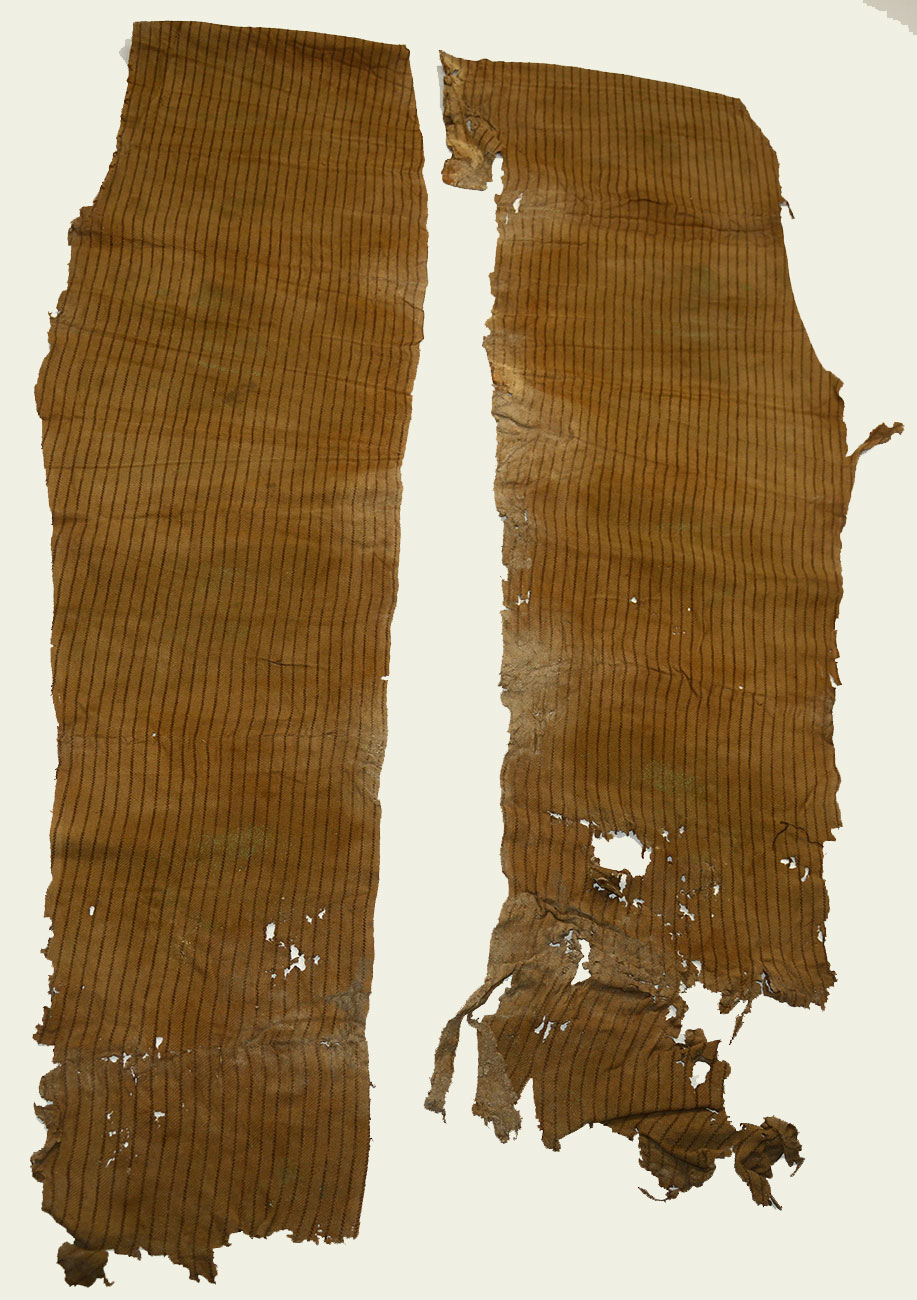site search
online catalog
KNIT DRAWERS OR TROUSERS FROM FORT PEMBINA

$450.00
Quantity Available: 1
Item Code: 1052-446
Shipping: Determined by Method & Location of buyer
To Order:
Call 717-334-0347,
Fax 717-334-5016, or E-mail
These pieces are two legs from trousers or, more likely, drawers recovered in the excavations at Fort Pembina, ND, conducted on private property with the owner’s permission, where wet, anaerobic soil conditions have yielded leather gear and cloth in remarkable states of preservation. Uniforms and gear show the garrison, like the rest of the army, was using Civil War surplus material well into the 1870s that was gradually phased out in a mix of later army issue patterns, experimental, and privately purchased clothing.
These are knit fabric, which a few Civil War contracts for drawers specify, and could be surplus or privately purchased. Indian War army issue drawers tended to be one weight of material, usually leaving the soldier too hot or too cold. These are in good condition, displayable, and able to be handled, with some holes and ragged edges mainly near the bottom and are now a light brown in color with some slightly darker stains. Needless to say, military underwear from the period of any sort, as essential as it was, is rare- hardly the thing to be preserved by veteran or his family as a cherished memento of army service.
Fort Pembina was established in 1870 by troops of the 20th US Infantry and as is typical of the early Indian Wars regular army, their issue uniforms were Civil War surplus well into the 1870s. Situated in the Red River Valley in North Dakota near the Canadian border, Ft. Pembina was in operation until 1895. Trading posts existed earlier in the area as part of the fur trade, and the first U.S. military post there was temporary- manned by a detachment of Minnesota troops in 1863-1864 following the 1862 Sioux uprising. In March 1870 a new fort was established south of the Pembina River and about 200 yards west of the Red River, completed by July and named in honor of Gen. George H. Thomas. The name was changed to Fort Pembina in September and the initial garrison consisted of two companies of the 20th US Infantry. Their main purpose was to provide security for settlers worried about Sioux returning south from Canada, but the troops spent much of their time escorting boundary surveys along the Canadian border and preventing Fenian raids heading north into Canada.
The fort included enlisted barracks, officers’ quarters, guard house, ordnance storehouse, company kitchen, root house, laundress’s quarters, quarters for civilian employees, hospital and hospital servant’s house, a barn for the “hospital cow,” quartermaster and commissary offices and storehouse, stables, wagon shed, etc. The garrison reached peak strength in 1878 of 200, but the average was about 125 enlisted men and 8 officers. An October 1885 return listed 97 men, 2 field pieces, 1 mountain howitzer, 100 rifles, 19 pistols, 23 mules, and 9 wagons. By 1890 the post had just 23 men, and after an 1895 fire destroyed some 19 buildings it was decided to abandon the fort rather than rebuild, the last detachment left in September. The property was turned over to the Interior Department and later sold in 1902.
These display very well, are scarce relics of army life on the frontier, and would make an interesting study piece in illustrating the postwar army’s material culture. [sr][ph:L]
~~~~~~~~~~~~~~~~~~~~~~~~~~~~~~~~~~~
THIS ITEM, AS WITH ALL OTHER ITEMS AVAILABLE ON OUR WEB SITE,
MAY BE PURCHASED THROUGH OUR LAYAWAY PROGRAM.
CLICK HERE FOR OUR POLICIES AND TERMS.
THANK YOU!
Inquire About KNIT DRAWERS OR TROUSERS FROM FORT PEMBINA
For inquiries, please email us at [email protected]
Most Popular
Historical Firearms Stolen From The National Civil War Museum In Harrisburg, Pa »
Theft From Gravesite Of Gen. John Reynolds »
Selection Of Unframed Prints By Don Troiani »
Fine Condition Brass Infantry Bugle Insignia »
British Imported, Confederate Used Bayonet »
Scarce New Model 1865 Sharps Still In Percussion Near Factory New »
featured item
HANDSOME INSCRIBED MOORE REVOLVER WITH HOLSTER OF C.H. RICHMOND
Moore revolvers used the .32 caliber self-contained metallic rimfire cartridge, which was available and convenient. They were not subject to damage by rough handling, weather resistant, and made a pistol fast to load. Moore also provided value for… (2023-2603). Learn More »
site search
Upcoming Events
May 16 - 18: N-SSA Spring Nationals, Fort Shenandoah, Winchester, VA Learn More »



